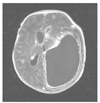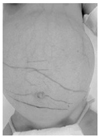Abstract
Some parasitic diseases are more prevalent in children than in adults. Such age-specific diseases usually result from the mode of infection. Enterobiasis and head lice infestations are contact-borne. Congenital toxoplasmosis is a transplacental infection. Hepatic capillariasis results from contact with an environment contaminated with cat stools. Enterobiasis is the most common helminthic disease in children. The diagnosis and treatment is difficult because of its characteristic life cycle: eggs are present at the end of the life of the female adult worm. Vigorous screening and repeated chemotherapy for the entire family and contact group are required. Recently, there have been reports of congenital toxoplasmosis. There may be an increase in the number of cases of toxoplasmosis owing to the increase in the number of stray cats. Cryptosporidiosis does not evoke serious illness in immunocompetent children, while severe diarrhea can occur in immunocompromised children. One case of hepatic capillariasis has been reported in Korea. Owing to its high morbidity and mortality, prompt diagnosis and treatment are required. Head lice infestation is easy to diagnose and is still an indication of public health status. Mass screening and prevention are required. In local clinics, parasitic diseases are rarely suspected, since their incidence is very low and the symptoms are usually non-specific, except in a few parasitic diseases. Therefore, a thorough evaluation of the symptoms and past history and appropriate laboratory tests are necessary.
References
1. Cho SY, Kang SY. Significance of Scotch-tape anal swab technique in diagnosis of Enterobius vermicularis infection. Korean J Parasitol. 1975. 13:102–114.

2. Cho SY, Kang SY, Ryang YS, Seo BS. Relationships between the results of repeated anal swab examinations and worm burden of Enterobius vermicularis. Korean J Parasitol. 1976. 14:109–116.

3. Hong ST, Cho SY, Seo BS, Yun CK. Chemotherapeutic control of Enterobius vermicularis infection in orphanages. Korean J Parasitol. 1980. 18:37–44.

4. Kim BJ, Lee BY, Chung HK, Lee YS, Lee KH, Ock MS, et al. Egg positive rate of Enterobius vermicularis of primary school children in Geoje island. Korean J Parasitol. 2003. 41:75–77.

5. Song HJ, Cho CH, Kim JS, Choi MH, Hong ST. Prevalence and risk factors for enterobiasis among preschool children in a metropolitan city in Korea. Parasitol Res. 2003. 91:46–50.

10. Sohn WM, Nam HW. Western blot analysis of stray cat sera against Toxoplasma gondii and the diagnostic availability of monoclonal antibodies in sandwich-ELISA. Korean J Parasitol. 1999. 37:249–256.

11. Jo EK, Kim HS, Lee MY, Iseki M, Lee JH, Kook H. et al. Xlinked Hyper-IgM Syndrome Associated with Cryptosporidium parvum and Cryptococcus neoformans Infections: the First Case with Molecular Diagnosis in Korea. J Korean Med Sci. 2002. 17:116–112.

12. Yu JR, Seo M. Infection status of pigs with Cryptosporidium parvum. Korean J Parasitol. 2004. 42:45–47.

13. Yu JR, Lee JK, Seo M, Kim SI, Sohn WM, Kim TS, et al. Prevalence of cryptosporidiosis among the villagers and domestic animals in several rural areas of Korea. Korean J Parasitol. 2004. 42:1–6.

14. Choe G, Lee HS, Seo JK, Chai JY, Lee SH, Chi JG, et al. Hepatic capillariasis: first case report in the Republic of Korea. Am J Trop Med Hyg. 1993. 48:610–625.

15. Seong JK, Huh S, Lee JS, Oh YS. Helminths in Rattus norvegicus captured in Chunchon, Korea. Korean J Parasitol. 1995. 33:235–237.





 PDF
PDF ePub
ePub Citation
Citation Print
Print









 XML Download
XML Download